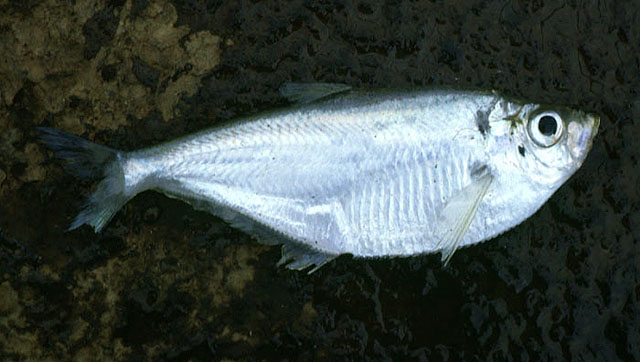|
Dorsal spines (total): 0-0; Dorsal soft rays (total): 14-17; Anal spines: 0-0; Anal soft rays: 45-50; Vertebrae: 42-43. Diagnosis: Body moderately deep, compressed, belly with a sharp and serrated keel of scutes from gill opening to anus, 25-27 pre-pelvic and 6-8 post-pelvic sharp scutes (Ref. 187, 188, 81270). Eye large, mouth pointing upwards, lower jaw projecting (Ref. 187, 188). Dorsal fin at or before midpoint of body; anal fin long, with more than 40 finrays, its origin below dorsal fin base; pelvic fins small (Ref. 187, 188). Swimbladder with two short tubes passing back in the muscles on either side of haemal spines (Ref. 188). Other clupeoid fishes in the area are more slender, have a much shorter anal fin and the lower jaw is not strongly projecting (Ref. 188).
Description: Body deep and strongly compressed, its depth comprised from 2.7 to 3.5 times in standard length (Ref. 2919, 81270). Eyes large (Ref. 188, 2919, 81270). Lower jaw prominent; no median notch on the premaxilla of upper jaw (Ref. 2919, 81270). Lower limb of first gill arch with 22-28 gillrakers; upper part with 9-11 gillrakers (Ref. 2919, 2982, 81270). Dorsal fin short, with 14-17 rays, its origin nearer end of snout than base of caudal fin; anal fin very long, with 45-50 rays; pectoral fins with 12-14 rays; pelvic fins with 6-8 rays (Ref. 1989, 2919, 81270, 117366). Number of lateral line scales 40-44; number of transversal scales 10-16; 14-16 predorsal scales (Ref. 2982, 86940). Sharp scutes; with 25-27 pre-pelvic scutes and 6-8 post-pelvic scutes (Ref. 188, 1989, 2919, 81270).
Colouration: In alcohol-preserved specimens, body silvery and a dark band runs from occiput to base of dorsal fin (Ref. 2919, 81270). Colour: back grey, flanks pale grey or silver, with a faint dark spot behind gill cover, green/gold when alive; dorsal fin yellow, with a dusky tip; pectoral fins with upper finrays yellow, the rest colourless, as also pelvic fins; anal fin with yellow border; caudal fin yellow with upper lobe and hind margin dusky (Ref. 187). |
| Found in the marine environment, pelagic, along beaches and just off shore, down to about 25 m, also in lagoons and estuaries, penetrating into almost freshwater (Ref. 187, 188, 54448). A marine migrant (Ref. 117399). Rarely found below 35 m depth (Ref. 86940). It feeds on small planktonic animals, e.g. small fish and crustaceans; it doesn't seem to feed on plankton (Ref. 188, 3166, 47405). |

